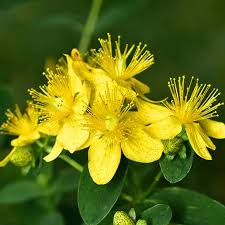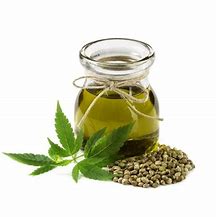St John's Wort Oil (macerated)







St John's Wort Oil (macerated)
Latin Name:
Hypericum perforatum Linnaeus
Family:
Hypericaceae, Clusiaceae
Etymology
Also known as hypericon is the ancient Greek name and one version of the root of this word is erica, meaning heather; another version is that hypericum is derived from two words, hype and eikon meaning over, and icon alluding to use of the herb as a protection against evil spirits. In the same vein, a common name used to be Fuga Demonum (Fernie 1897), Perforatum is from the Latin for perforated and applies to the 'perforated ' appearance of the leaves due to the translucent dots when held up to the light.
When the buds of this plant are crushed between the fingers hypericin is released, staining the fingers blood red. This coupled with the fact that the plant is in full flower on St John's day (24th June) and that St John was beheaded, is one explanation for the common name, because hypericum became known as herba Sanctus Joannis or, in English, St John's Wort. (Wortis from the Middle English wyrt meaning root, herb or plant.)
An alternative explanation is that the translucent 'dots' in the leaves looked like wounds and the plant was used during the crusades by the Knights of St John to heal their wounds.
The Plant and its Environment
There are 160 species of hypericum, nine of them British and H. perforatum is known as common hypericum. A perennial plant, hypericum stands almost 1 metre (39 inches) tall, is native to Britain and France, and spreads easily by means of runners. From summer to Autumn it is covered in flowers each with five slightly asymmetrical petals and many stamen.
The edges of the yellow flowers have small black dots which contain, among other pigments, hypericin (Bruneton 1995). When held up to the light the leaves appear to be covered in tiny holes which are the translucent oil glands. An essential oil can be obtained from hypericum, but the quantity is so small that production is not commercially viable.
The Oil
Hypericin is responsible for the deep red colour of the macerated oil.
Method of Extraction (maceration)
In the South of France, hypercinum buds and flowers are steeped in good quality vegetable oil (virgin olive oil is the preferred medium) for many days in full sun and with occasional agitation, after which the plant material is filtered off. Expose to sunlight reportedly results in a four fold increase in flavonoid content. (quercetin) (Maisenbacher & Kovar 1992(), Smith et al (1996) recommended that the flowers be macerated in oil at 45C for 10 days. while Hobbs ( 1989) recommends 70C for 12-24 hours.
The plant contains 0.059-0.35% of an essential oil consisting mainly of monoterpenes and sesquiterpenes (Benigni et al 1971) including 2 methyl octane (16.4% and a-pinene (10.65). Similar to some essential oils, the properties of hypericum may vary according to the season of harvest; the flavonoid and proanthocyanidins, useful in wound healing, are highest when flowers are in bud; for the antiviral activity, due to hypericin and pseudohypericin, the optimum time is when the flowers have just blossomed; hyperforin and adhyperforin are at their highest in the fruit/seed capsules for the best antidepressant action (Chevallier 1999).
Reference: Carrier Ouls For Aromatherapy and Massage: len Price with Ian Smith & Shirley Price
Articles-Most Read
- Home
- Contact Us
- Coconut Oil-2
- Absorption Ratings for Carrier Oils
- Cold Pressing Method
- What are Essential Fatty Acids
- Cherry Kernel Oil
- Fixed Oils and Skin Penetration
- Hempseed Oil
- Almond Oil
- Cocoa butter
- Camelina Oil
- Coconut Oil
- Antibacterial Effects Of Carrier Oil
- Lime Blossom Oil (macerated)
- Carrot Oil, Wild Carrot Oil (macerated)
- Apricot Kernel Oil
- Kukui Nut Oil
- Jojoba Wax
- Pumkin Seed Oil - Cucurbita maxima, C. pepo
- Passion Flower OIl (Macerated)
- Hydrocotyle Oil (macerated)
- Palm Kernel Oil
- Rapeseed Oil - Carrier Oil
- Nutrients
Who's On Line
We have 148 guests and no members online
Articles-Latest
- How to Make Homemade Olive Oil: A Step-by-Step Guide
- 20 Evidence-Based Aloe Vera Oil Benefits For Skin, Hair & Health
- Peanut oil - Cold pressed - Are There Health Benefits? How To Make
- What Are the Health Benefits of Black Seed Oil?
- Comfrey oil Infused
- Chamomile Flowers Infused Oil
- Calendula Flowers Infused Oil
- Arnica Flowers Infused Oil
- How To Make Herb-Infused Oils
- DIY avocado oil for healthy skin
- How To Make Coconut Oil
- 8 Benefits of Mustard Oil, Plus How to Use It
- SHOREA STENOPTERA SEED BUTTER
- Shea Butter- 7 Amazing Benefits Of Shea Butter
- Monoi Oil For Hair & Skin
- Mango Seed Oil
- Cohune Oil Is The Next Big Thing
- Brazil Nut OIl
- 7 Impressive Benefits Of Allspice
- Camelina Oil Benefits, Uses, and Side Effects




